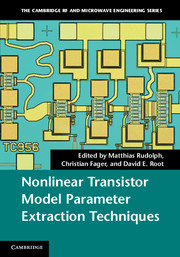Book contents
- Frontmatter
- Contents
- List of contributors
- Preface
- 1 Introduction
- 2 DC and thermal modeling: III–V FETs and HBTs
- 3 Extrinsic parameter and parasitic elements in III–V HBT and HEMT modeling
- 4 Uncertainties in small-signal equivalent circuit modeling
- 5 The large-signal model: theoretical foundations, practical considerations, and recent trends
- 6 Large and packaged transistors
- 7 Nonlinear characterization and modeling of dispersive effects in high-frequency power transistors
- 8 Optimizing microwave measurements for model construction and validation
- 9 Practical statistical simulation for efficient circuit design
- 10 Noise modeling
- Index
- References
4 - Uncertainties in small-signal equivalent circuit modeling
Published online by Cambridge University Press: 25 October 2011
- Frontmatter
- Contents
- List of contributors
- Preface
- 1 Introduction
- 2 DC and thermal modeling: III–V FETs and HBTs
- 3 Extrinsic parameter and parasitic elements in III–V HBT and HEMT modeling
- 4 Uncertainties in small-signal equivalent circuit modeling
- 5 The large-signal model: theoretical foundations, practical considerations, and recent trends
- 6 Large and packaged transistors
- 7 Nonlinear characterization and modeling of dispersive effects in high-frequency power transistors
- 8 Optimizing microwave measurements for model construction and validation
- 9 Practical statistical simulation for efficient circuit design
- 10 Noise modeling
- Index
- References
Summary
Introduction
Almost all computer-aided RF and microwave circuit design work relies on small-signal equivalent circuit models [1] (see Chapters 3 and 5). These models are used to replicate, as accurately as possible, the linearized electrical characteristics of the device under test. However, despite all efforts spent on deriving physically correct model topologies, surprisingly little research has been reported on how to extract the parameters of these models accurately.
There are several sources of uncertainty in the modeling process that contribute to inaccuracies in the models and their parameter estimates. By using a stochastic approach that acknowledges the fact that microwave and RF measurements are, indeed, associated with uncertainties and incorporating this approach with existing model extraction methods, it becomes possible to quantify the uncertainties in the models obtained. The statistical approach adopted in this chapter will be used as a framework for the application of statistical parameter estimation methods that are often used in other applications but not in the context of microwave and RF small-signal modeling. As a consequence, the accuracy of the models obtained is significantly improved when compared to traditionally used methods.
Different simple modeling examples will be used to illustrate how measurement uncertainties propagate to uncertainties in the models and their parameters when different extraction methods are applied. The application to small-signal transistor models will be of particular focus, since they form the basis for large signal transistor modeling and thus indirectly influence the performance when designing complex active circuits (see Chapter 5).
- Type
- Chapter
- Information
- Nonlinear Transistor Model Parameter Extraction Techniques , pp. 86 - 122Publisher: Cambridge University PressPrint publication year: 2011



